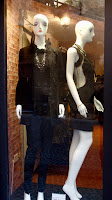Orvieto is filled with artists. There are painters and musicians, potters and leather workers, photographers, performers, and artisans creating things which, as yet, have no name. There is also the artist whose art is part of her trade. She may not think of herself as artistic at all, but she knows all about medium, context, and form.
I’ve seen evidence of bad taste. At the open market in Piazza del Popolo, for example, there are items for sale that take your breath away. But I don’t encounter the real thing very often. Apartments I’ve been invited into, or have glimpsed from the street, are unusually pleasant in their design and décor. The thirteenth century arch that leads to the dining room with the nineteenth century furniture is balanced by the canny placement of a twenty-first century lamp. That easy spontaneity shows up everywhere once your eye grows used to looking for it.
What really impresses me, though — maybe because it’s all over town, all of the time — is the design of shops and window displays.
 Orvieto’s window and shop art seems to be homegrown, not the product of professionals from Rome. The variety is too great, the attention to detail, too specific. That idea was reinforced by the shop owners who smiled at the Outsider pointing a camera at their stores. They nodded in that way that says “we did that.” There’s a different nod for “I bought that.” I’m pretty sure it was the “we did that” nod, most of the time.
Orvieto’s window and shop art seems to be homegrown, not the product of professionals from Rome. The variety is too great, the attention to detail, too specific. That idea was reinforced by the shop owners who smiled at the Outsider pointing a camera at their stores. They nodded in that way that says “we did that.” There’s a different nod for “I bought that.” I’m pretty sure it was the “we did that” nod, most of the time.
Displays range from the practical setups in the open markets to shop interiors that are sometimes so detailed they become environmental installations. That approach is so prevalent, that even walking into a pharmacy can feel like a designed immersive experience.
But the shop windows are scenographic gems, and you don’t have to step inside to appreciate them. They exist all over town, not just in the heavily trafficked thoroughfares. The front window of a shop tucked away in a narrow residential street can be as spectacularly attractive as one on Corso Cavour.
However visible a window is, most change more or less constantly. Some keep a personal style going while shifting detail to reflect the season, or the owner’s mood, or new products. Others undergo full transformations on a regular basis. The creativity, time, thought, and care invested in all this is staggering.
Then again, so much energy here is devoted to making everyday life, beautiful. The displays are a vibrant public expression of that. They are about more than advertizing product or trade, or boosting sales. They show pride of place, delight in culture, personality, a shared aesthetic, and a rich sense of humor. I find myself stopping at some windows like I do frescos in Firenze.
These photos capture a little of that, but don’t really do the subjects justice. The light is odd, I didn’t know how to handle the reflections, and the streets were so full there was no place to stand. They strain in the way that panorama shots often do. It’s hard to capture vibrance with pixels — or at least my pixels seem to be not quite up to the task.
Imagine the rest.
Or come see it in person.
Auguri!



